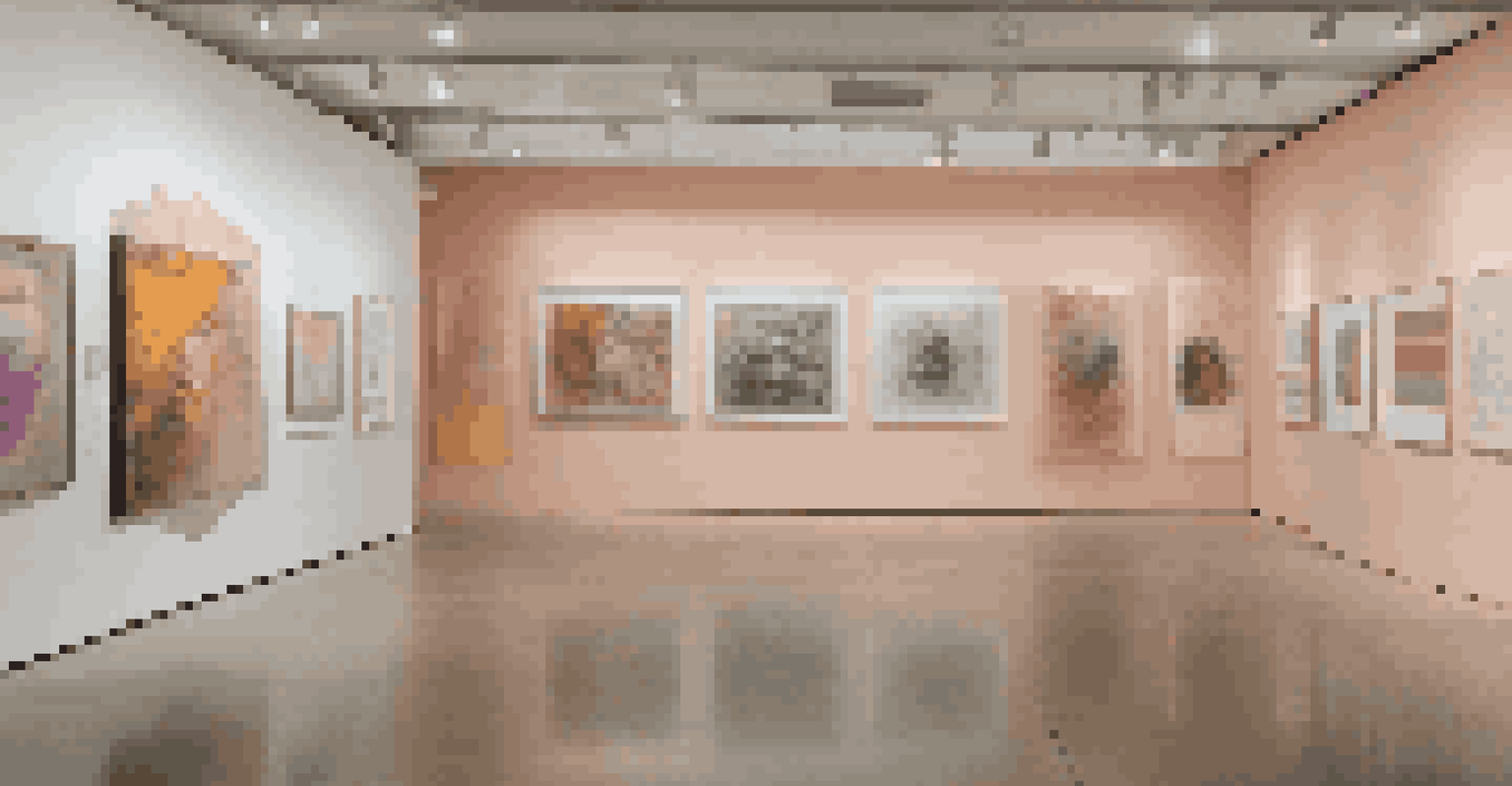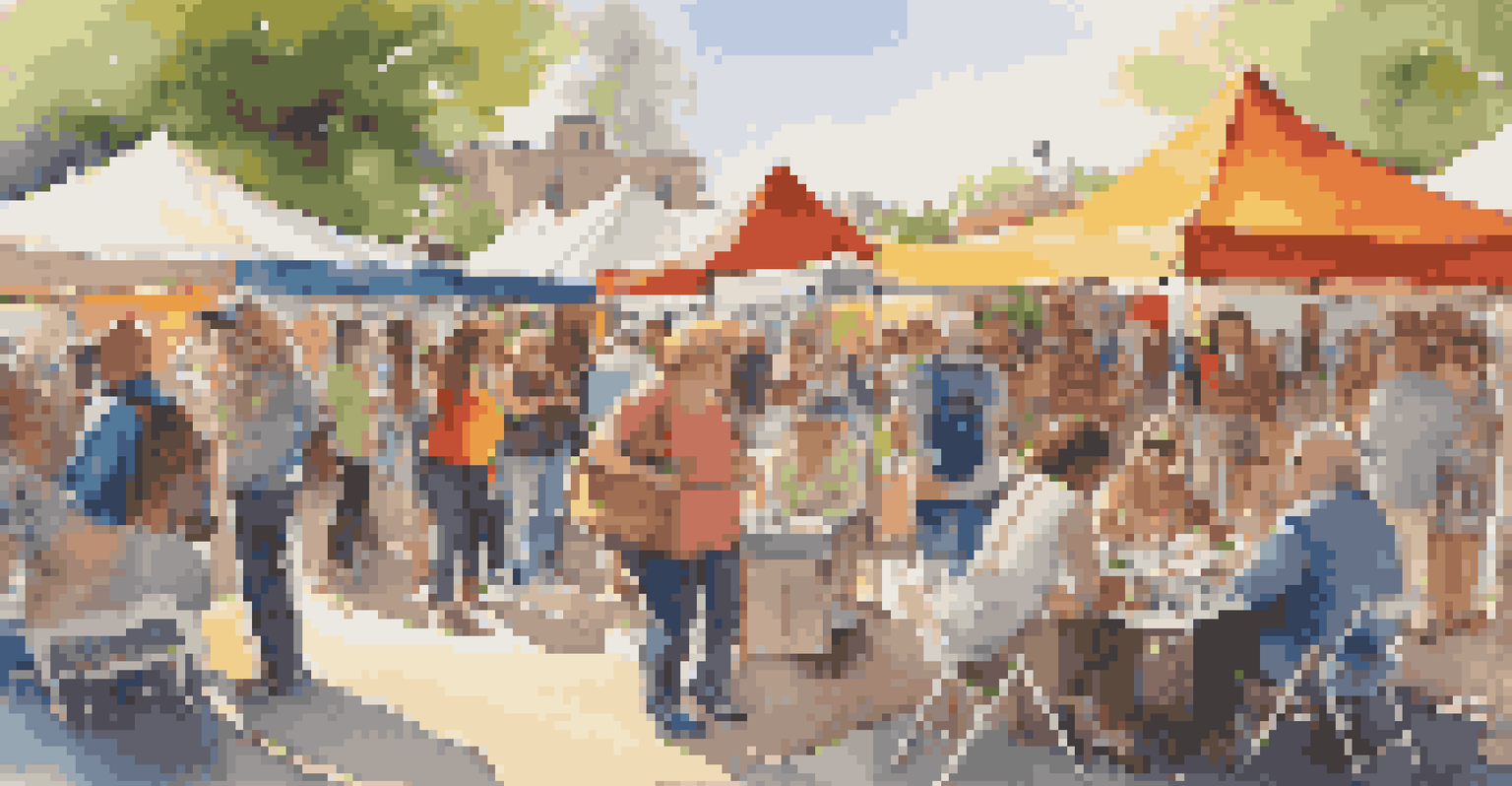Art and Identity Politics: Future Directions in Expression

Understanding Identity Politics in Contemporary Art
Identity politics refers to political positions rooted in the interests of social groups. In contemporary art, this concept has gained traction as artists seek to express their unique experiences and perspectives. By focusing on racial, gender, and sexual identities, artists create works that resonate with specific communities and challenge dominant narratives.
Art is not a mirror held up to reality, but a hammer with which to shape it.
For example, artists like Kehinde Wiley and Frida Kahlo use their backgrounds to explore themes of identity and representation. Their art serves as a powerful commentary on societal norms, urging viewers to reflect on their own identities. This approach not only personalizes art but also fosters a deeper understanding of diverse experiences.
As identity politics continues to evolve, it's essential to recognize how it shapes artistic expression. Artists are increasingly using their platforms to address social issues, advocating for change while simultaneously exploring their cultural heritage. This intersection makes the art world a vibrant space for dialogue and reflection.
The Role of Social Media in Art and Identity Politics
Social media has revolutionized the way artists share their work and connect with audiences. Platforms like Instagram and TikTok allow for instant feedback, enabling artists to engage in ongoing conversations about identity and politics. This immediacy fosters a sense of community and empowers marginalized voices to be heard.

For instance, hashtags like #BlackArtMatters and #QueerArt promote visibility for underrepresented artists. These movements encourage collaboration and support among artists from diverse backgrounds, creating a richer cultural tapestry. Through these digital spaces, artists can disseminate their messages far and wide, reaching audiences that traditional galleries may overlook.
Identity Politics Shapes Art
Contemporary artists use identity politics to express unique experiences, fostering dialogue and challenging societal norms.
Moreover, social media enables artists to experiment with new forms of expression, blending visual art with activism. The ability to share stories and experiences in real-time allows for a dynamic dialogue between creators and their audience. This interaction not only democratizes art but also amplifies the impact of identity politics in contemporary discourse.
Intersectionality: A Key Concept in Modern Artistic Expression
Intersectionality is a framework that examines how various forms of identity intersect to shape individual experiences. In the realm of art, this concept is crucial for understanding how multiple identities influence creative expression. Artists who embody intersectional identities often produce work that reflects the complexities of their lived experiences.
The role of the artist is to make the revolution irresistible.
For example, an artist who identifies as both Black and queer may create pieces that speak to the unique challenges faced by individuals at this intersection. This layered approach allows for a more nuanced exploration of identity, challenging simplistic categorizations. As a result, their work can resonate with a broader audience, fostering empathy and understanding.
By embracing intersectionality, artists not only enrich their own practice but also contribute to the discourse surrounding identity politics. This approach encourages collaboration and dialogue across diverse communities, promoting a more inclusive art world. As we move forward, intersectionality will continue to shape the future of artistic expression.
Art as Resistance: Challenging Dominant Narratives
Throughout history, art has served as a form of resistance against oppressive systems. Today, artists leverage their work to challenge dominant narratives that marginalize certain groups. By doing so, they create space for alternative stories, fostering a more inclusive understanding of culture and identity.
Take, for example, the work of Ai Weiwei, whose art often critiques authoritarian regimes. His installations not only highlight human rights abuses but also rally support for those who are silenced. This kind of activism through art exemplifies how creativity can be a powerful tool for social change.
Social Media Empowers Artists
Platforms like Instagram and TikTok allow artists to share their work and engage in meaningful conversations about identity and politics.
As we look to the future, the role of art as resistance will likely become even more pronounced. Artists will continue to confront societal injustices, using their platforms to amplify marginalized voices. This commitment to social justice will keep the dialogue around identity politics alive and relevant.
The Importance of Cultural Representation in Art
Cultural representation in art is vital for fostering understanding and appreciation of diverse experiences. When artists draw upon their cultural heritage, they contribute to a richer narrative that reflects the complexities of society. This representation not only validates individual identities but also educates audiences about different cultures.
For instance, the vibrant works of artists like Yayoi Kusama and Jean-Michel Basquiat showcase their unique cultural backgrounds while addressing universal themes. By integrating their cultural elements into their art, these creators invite viewers into their worlds, fostering empathy and connection. This exchange can break down stereotypes and promote a more inclusive society.
As the art world continues to evolve, the call for authentic representation will only grow stronger. Audiences are increasingly seeking diverse voices that challenge conventional norms. By prioritizing cultural representation, the art community can create a more equitable landscape that celebrates the richness of human experience.
Future Directions: Collaborative Art Practices
In recent years, collaborative art practices have gained popularity as artists seek to combine their unique perspectives. This approach not only enriches the creative process but also embodies the principles of identity politics by highlighting collective experiences. By working together, artists can create pieces that resonate with a wider audience.
Consider the collaborative installations of groups like the Guerrilla Girls, who use humor and activism to address gender inequality in the art world. Their collective voice amplifies the message, making it more impactful. This kind of collaboration fosters a sense of community, encouraging artists to support one another in their pursuits.
Globalization Influences Art
The interconnectedness of globalization enriches contemporary art, enabling artists to address complex themes of identity and cultural exchange.
As we move forward, we can expect to see more artists embracing collaboration as a means of expression. This shift will likely lead to innovative works that challenge traditional boundaries and explore the intersections of identity. The future of art lies in these collective efforts, which promise to create a more inclusive and dynamic cultural landscape.
The Impact of Globalization on Art and Identity Politics
Globalization has significantly influenced the art world, allowing for the exchange of ideas and cultural practices across borders. As artists from different backgrounds collaborate and share their work, they create a rich tapestry of influences that shape contemporary art. This interconnectedness fosters a greater understanding of global identity politics.
For example, the rise of transnational art movements has given voice to artists grappling with issues of migration, displacement, and cultural identity. These themes are increasingly relevant in today's world, as societies confront the complexities of globalization. Artists like El Anatsui and Ai Weiwei explore these topics, inviting viewers to reflect on the shared human experience.

In the future, we can expect globalization to continue shaping the discourse around art and identity politics. As artists engage with diverse perspectives, they will challenge traditional notions of culture and identity. This evolving landscape promises to create a more inclusive art world that reflects the complexities of our global society.